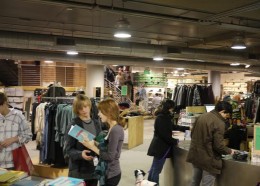How Fast Fashion Works Today

At Pacific Standard Christina Moon takes us behind-the-scenes of how “fast fashion” works today and the largely Korean immigrant population that is running it:
As an anthropologist, I have been coming to Los Angeles with the photographer Lauren Lancaster for the past two years to study the hundreds of Korean families who have, over the last decade, transformed the city’s garment district into a central hub for fast fashion in the Americas. These families make their living by designing clothes, organizing the factory labor that will cut and sew them in places like China and Vietnam, and selling them wholesale to many of the most famous retailers in the U.S. — including Forever 21, Urban Outfitters, T.J. Maxx, Anthropologie, and Nordstrom.
I first became curious about the garment sector in Los Angeles after noticing that an increasingly large proportion of students at Parsons, the New York design school where I teach, were second-generation children of Korean immigrants from Southern California. Many of them were studying fashion marketing and design so they could return to Los Angeles to help scale up their parents’ businesses. These students and their contemporaries were, I came to understand, the driving force behind U.S. fast fashion — a phenomenon whose rise is less a story about corporate innovation than one about an immigrant subculture coming of age.
And it is indeed fast: Three-month production cycles have turned to weeks. “A design idea for a blouse, cribbed from a runway show in Paris, can make it onto the racks in Wichita in a wide range of sizes within the space of a month.”
Photo: Kennejima
Support The Billfold
The Billfold continues to exist thanks to support from our readers. Help us continue to do our work by making a monthly pledge on Patreon or a one-time-only contribution through PayPal.
Comments